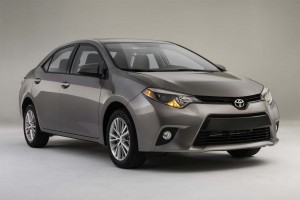For a vehicle with a payload capacity of 2,000 pounds and the ability to tow a 10,000-pound trailer, the 2014 Toyota Tundra will be expected to do some heavy lifting — and not just on the jobsite.
It’s been an unusually tough year for Toyota, both here and abroad. While the maker recently revealed it had narrowly retained its global sales lead, the gap between the Japanese giant and arch-rival General Motors markedly narrowed and while GM gained 4% for the first six months of 2013, Toyota was down 1.2%.
It hasn’t helped to be caught up in an ongoing political dispute between China and Japan that even saw rioters burn a Toyota dealership. But the maker has also had some unexpected setbacks in what has long been its most profitable market, the U.S., where two key lines: the midsize Camry and the Prius hybrid “family” suffered unanticipated sales declines. Meanwhile, the outgoing Toyota Tundra pickup has failed to take advantage of the revival of the U.S. truck market, the fastest-growing segment in the industry this year.
“Toyota will be perfectly positioned to take advantage of that growth,” once it launches a major update of the Tundra next month, predicted Bill Fay, the head of the flagship Toyota division for the U.S. market, during a media drive of the new pickup. He’s expecting a 30% jump in sales next year, to 137,000. But, in a market dominated by Detroit, that’s little more than an after-thought.
When the outgoing Tundra was introduced in 2007, many analysts had big expectations for the new truck. So did Toyota, which built a dedicated factory in San Antonio, Texas to handle production. But after initially topping 200,000, sales quickly plunged. While much of that was the result of the overall crash in pickup demand during the recession, Fay admits the truck has lagged the segment’s revival.
(Is the 2014 Toyota Tundra up to the test? Click Here for TheDetroitBureau.com review.)
And it’s not the only product challenge the maker is facing. The Camry, which has been the nation’s best-selling passenger car for more than a decade, suffered a 2% decline during the first half of the year even as the rest of the market surged. Meanwhile, the Prius, itself the long-dominant hybrid model, was off 5% between January and June.
Fay downplayed both problems, though he also acknowledges both of Toyota’s key models are facing much tougher competition. Ford, in fact, has made a successful point of targeting the various Prius models with an assortment of its own gas-electric models, including the Fusion Hybrid and C-Max Hybrid, which set sales records for the first half.
(Chevrolet Impala gets nod as top sedan from Consumer Reports. Click Here for the story.)
The Japanese maker has had to respond by cutting prices on the Camry and by ramping up incentives on both the midsize sedan and the various Prius hybrids. But it can afford to do so, noted analyst George Peterson, chief analyst with AutoPacific, Inc., noting that the weakened yen has given the Japanese maker more cash to play with.
While Toyota has been increasing incentives selectively, it still has some of the lowest givebacks in the market, an average $1,660 per vehicle in June, according to TrueCar.com, compared to $2,537 for the industry overall.
And Fay suggested Toyota could further rein in that spending with the launch of four new models in 2014, a list including not only the Tundra but an all-new version of the Corolla, the 800-pound gorilla in the compact sedan segment.
(For a first look at the new Toyota Corolla, Click Here.)
But analyst Peterson says Toyota has other worries that aren’t so easy to dismiss. The maker has been lagging in recent AutoPacific studies that focus on not only quality, reliability and dependability – traditional Toyota strengths – but also on the factors that surprise and delight consumers.
That was echoed by the results of the new J.D. Power APEAL study which also focuses on what the industry calls “things-gone-right” factors. While Volkswagen and Chevrolet led the industry, the Toyota brand landed fifth from the bottom. Perhaps equally disconcerting, GM also topped the more traditional J.D. Power Initial Quality Survey last month, handily outperforming Toyota.
(Toyota narrowly retains global sales lead. Click Here for the full story.)
“The competition isn’t standing still,” said Peterson. “Toyota has been building acceptable appliances for decades. Now they have to make products that are exciting and sexy.”
Indeed, the newly redesigned Toyota Avalon was supposed to be a prime example of what Toyota could do, underscoring the oft-stated goal of CEO Akio Toyoda to put more “passion” into the brand. But that isn’t as easy as it might seem, as Toyota was reminded when influential Consumer Reports magazine last week ranked the new Chevrolet Impala tops in the full-size sedan segment, besting the new Avalon.
This story first appeared on NBCNews.com.


